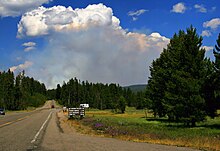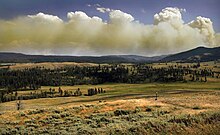Flammagenitus cloud


A flammagenitus cloud,[1] also known as a flammagenitus, pyrocumulus cloud, or fire cloud, is a dense cumuliform cloud associated with fire or volcanic eruptions.[2] A flammagenitus is similar dynamically in some ways to a firestorm, and the two phenomena may occur in conjunction with each other. However, either may occur without the other.[dubious ][citation needed]
Formation

A flammagenitus cloud is produced by the intense


Flammageniti contain severe turbulence, manifesting as strong gusts at the surface, which can exacerbate a large conflagration. A large flammagenitus, particularly one associated with a volcanic eruption, may also produce
Appearance

Flammagenitus is often grayish to brown in color because of the ash and smoke associated with the fire. It also tends to expand because the ash involved in the cloud's formation increases the amount of condensation nuclei.

Effects on wildfires
A flammagenitus cloud can help or hinder a fire. Sometimes, the moisture from the air condenses in the cloud and falls as rain, often extinguishing the fire. There have been numerous examples of a large firestorm being extinguished by the flammagenitus that it created.
References
- ^ "Flammagenitus". World Meteorological Association. Archived from the original on 28 March 2017. Retrieved 27 March 2017.
- ^ "Pyrocumulus entry in the AMS Glossary". Archived from the original on 2022-12-19. Retrieved 2017-03-28.
- ^ Sutherland, Scott (March 23, 2017). "Cloud Atlas leaps into 21st century with 12 new cloud types". The Weather Network. Pelmorex Media. Archived from the original on 31 May 2022. Retrieved 24 March 2017.
- ^ Csifo, Noemi. "Fire Cloud Cumulus Cumulonimbus Weather". Sciences 360. R R Donelley. Archived from the original on 22 October 2013. Retrieved 22 October 2013.
- ^ "Pyrocumulus by The Airline Pilots". Archived from the original on 2011-09-28. Retrieved 2009-01-02.
External links
 Media related to Flammagenitus clouds at Wikimedia Commons
Media related to Flammagenitus clouds at Wikimedia Commons
